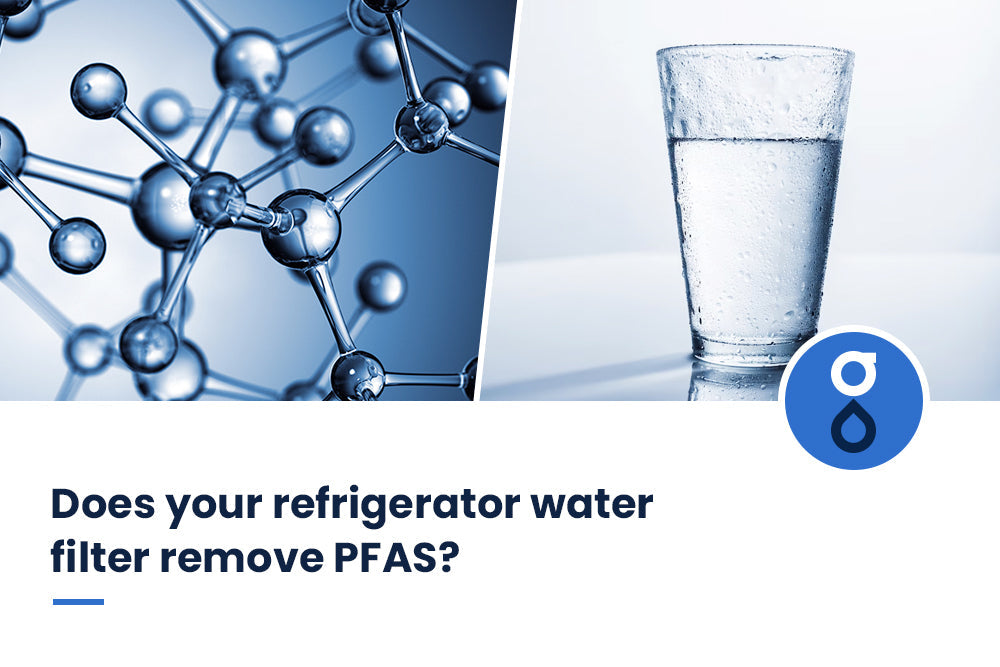Table of Contents:
What are PFAS
Types of PFAS
The potential health risks of PFAS exposure
Do your refrigerator water filters remove PFAS
How to test for PFAS in water
Methods to reduce PFAS exposure
FAQs
Conclusion
False, False! Do you know what PFAS are? They are a class of artificial chemicals used in various products in our everyday lives. Unfortunately, PFAS can be found in many drinking water sources and can harm our health. That's why knowing if your refrigerator water filter can remove PFAS from your drinking water is essential.
In this article, we'll look at what PFAS are, the types of refrigerator water filters available, how effective they are at removing PFAS, and tips for choosing the right filter and removing PFAS from drinking water.
What are PFAS?
PFAS (per- and polyfluoroalkyl substances) are a group of man-made chemicals that have been widely used since the 1950s in various industries and consumer products, such as non-stick cookware, stain-resistant carpeting, firefighting foam, and food packaging. The reason for their popularity is their ability to resist heat, water, and oil. However, PFAS chemicals have been linked to numerous health problems, including kidney and testicular cancer, hormonal disruption, developmental delays, and fetal development issues. Moreover, studies have shown that these chemicals can accumulate in the body and remain for long periods.

Two of the most common PFAS chemicals are PFOA (perfluorooctanoic acid) and PFOS (perfluorooctanesulfonic acid). These compounds have been phased out in the US due to their hazardous nature, though PFAS chemicals are still found in other products. One of the most concerning issues related to PFAS compounds is their presence in drinking water. PFAS contamination can occur when these chemicals seep into soil and groundwater near facilities that use or dispose of them. Drinking water contamination has been reported near military bases, industrial facilities, and areas that use firefighting foam. The extent of PFAS exposure in the US population is still being studied, but it is believed that most people have been exposed to these harmful chemicals to some degree. The EPA has set a health advisory level of 70 parts per trillion (ppt) for PFOA and PFOS in drinking water. However, some states have set more stringent levels due to concerns over adverse health effects.
Types of PFAS
Several types of PFAS fall under this umbrella term. Among the most commonly studied are perfluorooctanoic acid (PFOA), perfluorooctane sulfonate (PFOS), hexafluoropropylene oxide dimer acid (GenX), perfluorononanoic acid (PFNA), and perfluorobutane sulfonate (PFBS).
PFOA
Perfluorooctanoic acid (PFOA) is an artificial chemical part of a larger group of chemicals known as perfluoroalkyl and poly-fluoroalkyl substances, or PFASs. PFOA has gained notoriety due to its potential role in PFAS contamination. PFOA has been used in various industrial and consumer products, including non-stick cookware, coatings for carpets and textiles, and firefighting foams. Its chemical properties make it useful in these applications because it is a strong surfactant with high heat resistance. Exposure to PFOA has been linked to a range of health effects, including effects on cholesterol levels, liver damage, and an increased risk of certain cancers. Additionally, it has been associated with decreased birth weight and developmental delays in children.
PFOS
PFOS is a synthetic compound with a highly stable carbon-fluorine bond, making it resistant to environmental degradation and persistent in biological tissues. It was mainly used in non-stick cookware, stain-resistant fabrics, water-resistant clothing, and coatings for industrial equipment. Moreover, it was a critical component of firefighting foam. Its stable chemical bond allows it to resist breakdown and remain in the environment for prolonged periods.
Studies have indicated that prolonged exposure to PFOS is linked to numerous adverse health effects. These effects include damage to cholesterol levels, reduced birth weight, and developmental issues in children. Furthermore, studies have demonstrated that PFOS exposure could increase the risk of cancer, immune system damage, and other health conditions. To address the increasing risks associated with PFOS exposure, the Environmental Protection Agency (EPA) has implemented regulations under the Safe Drinking Water Act. The EPA recommended an advisory level of 70 ppt (parts per trillion) for drinking water, which has been revised to an even lower level of 15 ppt in recent years. These guidelines have helped to limit the levels of PFOS in drinking water and protect consumers from potential health hazards.
GenX
GenX is a type of per- and polyfluoroalkyl substance (PFAS) found in drinking water sources across the United States. These types of substances were commonly used in nonstick cookware, as well as military firefighting foam. PFAS chemicals have been linked with adverse health effects, including developmental and reproductive issues, and GenX is no exception.
Sources of GenX contamination include industrial sites, military bases, and wastewater treatment plants. GenX can enter water sources through various pathways, including direct discharge from facilities that use or produce chemical and wastewater treatment facilities that may not be equipped to remove all PFAS substances. GenX is not regulated by the Environmental Protection Agency (EPA) despite its potential health risks, and no advisory level has been set. This means it is up to individuals to ensure that their drinking water is adequately filtered to remove this harmful substance.
PFNA
PFNA belongs to a group of artificial chemicals developed in the mid-twentieth century and used in a wide range of industrial and commercial applications like firefighting foams, nonstick cookware, and stain-resistant fabrics. Several studies have indicated that PFNA can damage various organ systems in the body, including the reproductive system, kidney, and liver. Exposure to PFNA has also been linked to higher cholesterol levels, and several studies have revealed that elevated PFNA levels are associated with an increased incidence of adverse health effects. Furthermore, recent research shows that PFNA can affect the immune system and may pose a risk to developing fetuses.
PFBS
Compared to PFOA and PFOS, which are also types of PFAS, PFBS has a shorter chain length and is considered less toxic. However, it is essential to note that even low levels of exposure to PFAS can potentially cause adverse health effects. PFBS poses a concern because it is persistent in the environment and has the potential to accumulate in both the environment and the human body. This accumulation has raised concerns regarding the potential long-term effects of PFBS exposure on human health.
While some water filtration methods, such as carbon filters and reverse osmosis systems, have effectively removed PFAS from drinking water sources, it is essential to consider PFBS when assessing the effectiveness of water filtration systems. Refrigerator water filters have also been found to remove PFAS from drinking water effectively.
The potential health risks of PFAS exposure
One of the most concerning risks is the impact on fertility. Studies have shown that higher levels of PFAS exposure could decrease fertility in both men and women. Exposure to PFAS during pregnancy has also been linked to developmental delays and behavioral disorders in children. Furthermore, PFAS exposure has been associated with hormone-related conditions such as accelerated puberty and a higher risk of kidney, prostate, and testicular cancers. It can also impair immune system function and negatively affect cholesterol levels, potentially leading to cardiovascular diseases.
PFAS is persistent in the environment and the human body, meaning it can persist for a long time without breaking down. It has been linked to various diseases, such as thyroid hormone disruption, liver disease, and cancer. The potential health risks associated with PFAS exposure are numerous and varied. It is essential to be aware of the risks associated with these chemicals and to take steps to reduce exposure where possible.
Do your refrigerator water filters remove PFAS?

While refrigerator water filters can improve the taste and odor of your drinking water, they are not certified to remove PFAS chemicals. Instead, homeowners concerned about the presence of PFAS in their tap water should consider using alternative water filtration options, such as activated-carbon filters, reverse osmosis systems, or whole-house filtration systems. These options effectively remove PFAS and other potentially harmful chemicals from drinking water.
Suppose you choose to continue using your refrigerator water filter and, in that case, replace the filter cartridge every six months and monitor the water flow to determine if filter replacement is necessary. Consumers should also look for water filters certified by NSF/ANSI 53 and NSF/ANSI 58, designed to eliminate PFAS and other contaminants effectively. Additionally, it is essential to be aware of contamination sites, such as military bases and public water systems, and to have your water tested regularly to ensure the safety and quality of your drinking water.
How to test for PFAS in water
Testing for PFAS chemicals in water is becoming increasingly important due to their harmful effects on human health. Trying for these chemicals in your water is relatively easy and can provide you and your family peace of mind.
One of the most accurate ways to test for PFAS in water is to send a sample to a certified drinking water laboratory. These labs use advanced technologies to detect the slightest traces of these chemicals in your water. Alternatively, you can purchase a private testing package from a laboratory, such as SimpleLab's Tap Score PFAS Water Test. SimpleLab's Tap Score PFAS Water Test is affordable for those looking to test their water quality. This test covers 14 of the most common forever chemicals, including PFOA and PFOS. The testing process is simple and includes everything you need.
To test your water with the SimpleLab Tap Score PFAS Water Test, collect a sample of your well or city water according to the provided instructions and mail it to their laboratory using the postage-paid box provided. This will ensure that the sample is handled correctly and arrives at the laboratory in good condition. Results will be provided in about a week, along with a list of steps to take next based on the detected levels of PFAS in your water.
Methods to reduce PFAS exposure
Avoid products containing PFAS

Non-stick cookware, such as Teflon pans, contains PFAS chemicals. When heated, these materials can release toxic fumes that can cause flu-like symptoms known as Teflon flu. In addition, when PFAS-coated cookware is scratched or damaged, the chemicals can leach into the food, leading to long-term health issues. Firefighting foam is another product that contains PFAS chemicals. This foam is used to extinguish fires caused by flammable liquids such as gasoline, jet fuel, and oil. However, the use of firefighting foam has been linked to contamination at military bases, airports, and other contamination sites. And stain-resistant fabrics, such as carpets and upholstery, also contain PFAS chemicals. Exposure to these chemicals can lead to developmental delays, low birth weight, and hormone-related disorders, among other health issues.
To avoid exposure to these hazardous chemicals, it is best to opt for safer alternatives. For instance, instead of using Teflon pans, consider using cast iron or stainless steel cookware. For fire extinguishing, methods other than firefighting foam should be utilized. Similarly, you may want to avoid stain-resistant fabrics, or consider using natural materials such as wool or cotton.
Using water filtration systems
If you're looking for a solution to remove PFAS from your drinking water, several types of water filtration systems are available on the market.

Carbon filters, which are commonly found in water pitchers, can remove some PFAS. However, they are ineffective in removing all types of PFAS, including the shorter-chain ones. These filters must be changed regularly, which can be costly in the long run. Examples of recommended brands include Brita and PUR. Reverse osmosis systems are highly effective in removing PFAS from water, earning them a spot as one of the most recommended filtration systems. These systems force water through a semipermeable membrane that catches anything larger than a water molecule, including PFAS and other harmful chemicals. The downside of these systems is their price tag, typically ranging from 200$-400$ and needing to be changed annually.
Ionic fluoro gel resin is another highly effective option to remove PFAS from water. This system uses resin-coated fibers that bind to PFAS, trapping and preventing them from passing through. The downside is that this system is relatively expensive and less commonly available in retail stores or online.
Consuming organic food
Research has shown that PFAS can also be found in food products, especially in meat, poultry, and fish, which can be contaminated with firefighting foam or through contaminated water sources. However, consuming organic food can assist in reducing the intake of PFAS and, therefore, protect against these harmful effects. Unlike conventional farming practices, organic farming does not use pesticides, herbicides, or fertilizers that contain PFAS. As a result, the organic food produced does not accumulate the hazardous chemicals found in industrial farming.

Moreover, organically grown food undergoes rigorous testing and certification processes to ensure that it is free from additional contaminants, including PFAS. The certification process helps to ensure the quality and purity of the food produced. It also mandates frequent testing of water sources and soil to ensure it is free from dangerous chemicals. By consuming organic food, individuals can significantly reduce their PFAS and other harmful chemicals intake.
Follow disposal instructions for products containing PFAS
It's crucial to be mindful of how we dispose of PFAS products. Not following the instructions on the label when disposing of these products can result in a greater risk of environmental contamination, especially if they are released into waterways and soil. It's important to note how and where to dispose of any items containing PFAS properly.
For example, many states have specific regulations for adequately disposing of firefighting foams and other PFAS-containing consumer products like non-stick cookware, food packaging, and stain-resistant carpeting. In some areas, this may involve taking such items to hazardous waste collection sites or contacting local authorities for more information. Additionally, it's essential to check with local authorities about any restrictions or additional regulations regarding the disposal of these items. Taking these steps ensures that PFAS do not end up in an environment that could cause harm.
FAQs
Are there any alternatives to PFAS-containing products?
Yes. As PFAS are used in many everyday household items, such as cookware and fabric protectors, it's essential to look for safer options. Non-stick pans made with ceramic coatings or stainless steel are a great alternative to traditional non-stick pans. Additionally, natural fiber clothing is another option for fabrics that don't contain PFAS. Lastly, use honest cleaners instead of chemicals to reduce exposure to these toxic compounds.
Are there any regulations or laws in place to reduce PFAS exposure?
Regulations and laws to reduce PFAS exposure are being implemented around the world. In the U.S., the Environmental Protection Agency (EPA) has established a Maximum Contaminant Level Goal (MCLG) for two specific PFAS chemicals, PFOA and PFOS. The EPA also has issued a national health advisory level for drinking water containing PFAS chemicals and established regulations on industrial discharges of these compounds into surface waters. Other countries like Canada and Australia have also implemented rules to reduce PFAS exposure.
How can I tell if a product contains PFAS?
It can be challenging to tell if a product contains PFAS, as there are thousands of different types of PFAS, and not all products list them on the label. Some ways that you can identify if a product contains PFAS is to look for terms such as "fluoro" or "perfluoro" in the ingredients list or check with the manufacturer. Additionally, many states have started releasing lists of products that contain PFAS, so it's a good idea to check with your local health department or environmental agency for more information.
Conclusion
In conclusion, a refrigerator water filter can be an effective method for removing PFAS from drinking water. Choosing the right filter for your particular refrigerator model is essential, as some filters may be more effective than others at removing PFAS. Regular filter changes and maintenance can ensure your filter works efficiently. And using a quality refrigerator water filter can help reduce the amount of PFAS in your drinking water and protect your family's health. Follow Glacier Fresh to find more water filtration solutions.
















